History
The Williamstown Fire Company #1 was started in
1909 but we were not formally organized until 1911 by a group of
townspeople who saw the need for a fire brigade to protect their
properties. The first piece of fire equipment was a two wheel hose
cart, hand drawn and still in possession of the fire company. Water
was supplied in the center of Williamstown by mains laid and
supplied by the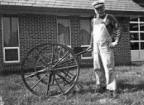 Williamstown GlassWorks, a flourishing industry until 1920. Soon,
another two-wheeled hose cart was purchased along with a hand-drawn
ladder wagon. One of the carts was housed in a 6′x8′ wooden building
on Glassboro Road and the other cart and ladder wagon in a building
on Library Street. The organization took place in what was known as
Smedley Hall, now a storage building behind the old Lanzalotti
Appliance Store on Main Street, just south of Clayton Road. The
first fire chief elected was Donlevy Loughlin.
Williamstown GlassWorks, a flourishing industry until 1920. Soon,
another two-wheeled hose cart was purchased along with a hand-drawn
ladder wagon. One of the carts was housed in a 6′x8′ wooden building
on Glassboro Road and the other cart and ladder wagon in a building
on Library Street. The organization took place in what was known as
Smedley Hall, now a storage building behind the old Lanzalotti
Appliance Store on Main Street, just south of Clayton Road. The
first fire chief elected was Donlevy Loughlin.
Fire alarms were sounded on the glass company’s steam whistle which was powerful enough to be heard seven miles away. In about 1923, a horse drawn fire wagon was purchased but since no horses were available for fire use, the wagon was pulled by the members of the fire company. This changed when Cliff Evans, one of the members, purchased an automobile. He then volunteered his auto to pull the wagon.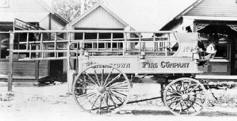 Mathis
Wise, who joined the Williamstown Fire Company in 1913 and boasted
of holding every office in the company with the exception of
treasurer during his 23 years of active service, often told the
story of the time the tow rope broke on the way to a fire and the
wagon ended up through a late glass window of the store at the
corner of Clayton Road and Main Street, with the wagon man Bill
Singer, aboard as acting brakeman, helplessly sitting on the
driver’s seat.
Mathis
Wise, who joined the Williamstown Fire Company in 1913 and boasted
of holding every office in the company with the exception of
treasurer during his 23 years of active service, often told the
story of the time the tow rope broke on the way to a fire and the
wagon ended up through a late glass window of the store at the
corner of Clayton Road and Main Street, with the wagon man Bill
Singer, aboard as acting brakeman, helplessly sitting on the
driver’s seat.
During 1916 the fire company purchased a used Studebaker hearse for the local mortician R.E. Buck. The hearse body was removed and the horse wagon body mounted on the chassis. One of the hardships then was the lack of experienced drivers. Only three men knew how to operate a motor vehicle; M.C. Wise, electrician, R.E. Buck, mortician, and William T. Sise. Because of the extended drive shaft, the “fire truck” was always breaking down and proved nothing but a headache for the local smoke eaters. In 1918 a New Reo fire truck was purchased under the leadership of Chief Lawrence “Rence” Lafferty and a firehouse was erected on Blue Bell Road between Main Street and Library Street. This wooden frame building housed the equipment and served as a meeting place.
An American LaFrance pumper was purchased in 1928 and housed at the Blue Bell Road location. This building later served as a Boy Scouts hall and then as the first ambulance headquarters. It was demolished to make room for St. Mary’s school playground. With the erection of this wooden firehouse, an electrical, one-phase fire siren was purchased and placed atop a windmill tower behind the Trout homestead between Main Street and Blue Bell Road, adjacent to the firehouse. The Trout family could sound the alarm and later a switch was installed in the local telephone exchange under control of the operator on duty. Those who had telephones would call the operator for the location of the fire. Today, modern radio equipment allows the firemen to receive the alarm directly for a central county dispatcher.
The township erected a new Municipal Building in 193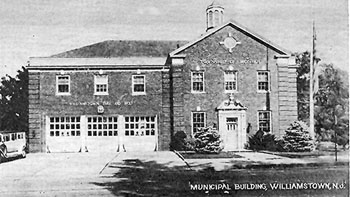 0. The building
was located at the corner of Main and Hall Streets.
Included was a firehouse section, large enough to house three pieces
of equipment. A meeting room was provided in the basement for the
firemen.1938 saw the purchase of a new three phase double end siren
that was mounted on a cross member of the old water tower on Blue
Bell Road. The old siren was placed on the roof of the old Grange
Hall on route 322 and operated simultaneously with the new siren.
0. The building
was located at the corner of Main and Hall Streets.
Included was a firehouse section, large enough to house three pieces
of equipment. A meeting room was provided in the basement for the
firemen.1938 saw the purchase of a new three phase double end siren
that was mounted on a cross member of the old water tower on Blue
Bell Road. The old siren was placed on the roof of the old Grange
Hall on route 322 and operated simultaneously with the new siren.
When membership declined in the late 1950′s, the company adopted a junior membership roll. Many of these juniors went on to become regular members.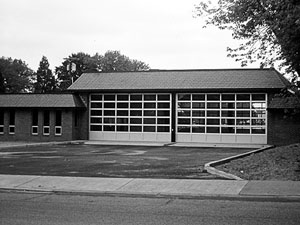 In 1975 the Township constructed a new Fire Station and Police
Headquarters on a site that was once a railroad yard. The new Fire
Station was dedicated in July, 1975 and included an apparatus room
with space for eight fire trucks, a hose drying room,and front and
rear drive-in doors.
The administration portion includes a dispatch room, offices for the
president, the chief, the secretary, and the treasurer, a conference
room, meeting rom, and kitchen.
In 1975 the Township constructed a new Fire Station and Police
Headquarters on a site that was once a railroad yard. The new Fire
Station was dedicated in July, 1975 and included an apparatus room
with space for eight fire trucks, a hose drying room,and front and
rear drive-in doors.
The administration portion includes a dispatch room, offices for the
president, the chief, the secretary, and the treasurer, a conference
room, meeting rom, and kitchen.
In 2003, the fire department housed a new pumper and dedicated a new modern substation. The substation was named Station #2 and is located on route 322 in the western section of the township. It will compliment the main station located at Virginia Ave and Main Street. The new station has four engine bays with front and rear doors, a communication room, and a large conference room on the first floor. The second floor contains two bunk rooms, a day room, full kitchen, and exercise room and two shower/bath rooms.
The fire company participates in all of the local parades and fire company functions within a reasonable distance. Demonstrations and lectures are arranged and given in schools and civic meetings. Firemen are called upon to serve during severe storms, rescue work, assisting fire victims and many other types of emergencies. The records show that many members have slept on the trucks during severe storms and power failures.
The Williamstown Fire Company #1 is a member of the New Jersey State Fireman’s Association, regulated by state legislature. In the 90 years as members, Williamstown has been represented every year at their annual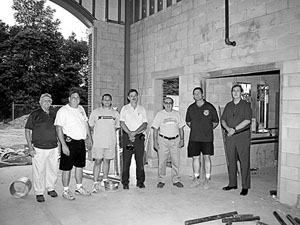 convention where new regulations and elections are
held. Money to administer the association is collected from
insurance companies doing business in the state.
Any fireman in need
can receive some compensation. Upon death, the family of a member
receives a given amount. Many years ago, the local firemen
experienced a loss on the life insurance policies of each of the
members and as a result took on the task of underwriting their own
life insurance. An association was formed over 70 years ago and
called the Death Burial Fund Association. Upon death, a fireman’s
family receives a pro rated amount to help defray expenses. Money
for this fund is solicited once a year from the residents and is
invested under the control of an elected board of trustees.
Over the many past years, this volunteer organization has been the
focal point for social and community functions.
convention where new regulations and elections are
held. Money to administer the association is collected from
insurance companies doing business in the state.
Any fireman in need
can receive some compensation. Upon death, the family of a member
receives a given amount. Many years ago, the local firemen
experienced a loss on the life insurance policies of each of the
members and as a result took on the task of underwriting their own
life insurance. An association was formed over 70 years ago and
called the Death Burial Fund Association. Upon death, a fireman’s
family receives a pro rated amount to help defray expenses. Money
for this fund is solicited once a year from the residents and is
invested under the control of an elected board of trustees.
Over the many past years, this volunteer organization has been the
focal point for social and community functions.
 Williamstown GlassWorks, a flourishing industry until 1920. Soon,
another two-wheeled hose cart was purchased along with a hand-drawn
ladder wagon. One of the carts was housed in a 6′x8′ wooden building
on Glassboro Road and the other cart and ladder wagon in a building
on Library Street. The organization took place in what was known as
Smedley Hall, now a storage building behind the old Lanzalotti
Appliance Store on Main Street, just south of Clayton Road. The
first fire chief elected was Donlevy Loughlin.
Williamstown GlassWorks, a flourishing industry until 1920. Soon,
another two-wheeled hose cart was purchased along with a hand-drawn
ladder wagon. One of the carts was housed in a 6′x8′ wooden building
on Glassboro Road and the other cart and ladder wagon in a building
on Library Street. The organization took place in what was known as
Smedley Hall, now a storage building behind the old Lanzalotti
Appliance Store on Main Street, just south of Clayton Road. The
first fire chief elected was Donlevy Loughlin. Fire alarms were sounded on the glass company’s steam whistle which was powerful enough to be heard seven miles away. In about 1923, a horse drawn fire wagon was purchased but since no horses were available for fire use, the wagon was pulled by the members of the fire company. This changed when Cliff Evans, one of the members, purchased an automobile. He then volunteered his auto to pull the wagon.
 Mathis
Wise, who joined the Williamstown Fire Company in 1913 and boasted
of holding every office in the company with the exception of
treasurer during his 23 years of active service, often told the
story of the time the tow rope broke on the way to a fire and the
wagon ended up through a late glass window of the store at the
corner of Clayton Road and Main Street, with the wagon man Bill
Singer, aboard as acting brakeman, helplessly sitting on the
driver’s seat.
Mathis
Wise, who joined the Williamstown Fire Company in 1913 and boasted
of holding every office in the company with the exception of
treasurer during his 23 years of active service, often told the
story of the time the tow rope broke on the way to a fire and the
wagon ended up through a late glass window of the store at the
corner of Clayton Road and Main Street, with the wagon man Bill
Singer, aboard as acting brakeman, helplessly sitting on the
driver’s seat. During 1916 the fire company purchased a used Studebaker hearse for the local mortician R.E. Buck. The hearse body was removed and the horse wagon body mounted on the chassis. One of the hardships then was the lack of experienced drivers. Only three men knew how to operate a motor vehicle; M.C. Wise, electrician, R.E. Buck, mortician, and William T. Sise. Because of the extended drive shaft, the “fire truck” was always breaking down and proved nothing but a headache for the local smoke eaters. In 1918 a New Reo fire truck was purchased under the leadership of Chief Lawrence “Rence” Lafferty and a firehouse was erected on Blue Bell Road between Main Street and Library Street. This wooden frame building housed the equipment and served as a meeting place.
An American LaFrance pumper was purchased in 1928 and housed at the Blue Bell Road location. This building later served as a Boy Scouts hall and then as the first ambulance headquarters. It was demolished to make room for St. Mary’s school playground. With the erection of this wooden firehouse, an electrical, one-phase fire siren was purchased and placed atop a windmill tower behind the Trout homestead between Main Street and Blue Bell Road, adjacent to the firehouse. The Trout family could sound the alarm and later a switch was installed in the local telephone exchange under control of the operator on duty. Those who had telephones would call the operator for the location of the fire. Today, modern radio equipment allows the firemen to receive the alarm directly for a central county dispatcher.
The township erected a new Municipal Building in 193
 0. The building
was located at the corner of Main and Hall Streets.
Included was a firehouse section, large enough to house three pieces
of equipment. A meeting room was provided in the basement for the
firemen.1938 saw the purchase of a new three phase double end siren
that was mounted on a cross member of the old water tower on Blue
Bell Road. The old siren was placed on the roof of the old Grange
Hall on route 322 and operated simultaneously with the new siren.
0. The building
was located at the corner of Main and Hall Streets.
Included was a firehouse section, large enough to house three pieces
of equipment. A meeting room was provided in the basement for the
firemen.1938 saw the purchase of a new three phase double end siren
that was mounted on a cross member of the old water tower on Blue
Bell Road. The old siren was placed on the roof of the old Grange
Hall on route 322 and operated simultaneously with the new siren.When membership declined in the late 1950′s, the company adopted a junior membership roll. Many of these juniors went on to become regular members.
 In 1975 the Township constructed a new Fire Station and Police
Headquarters on a site that was once a railroad yard. The new Fire
Station was dedicated in July, 1975 and included an apparatus room
with space for eight fire trucks, a hose drying room,and front and
rear drive-in doors.
The administration portion includes a dispatch room, offices for the
president, the chief, the secretary, and the treasurer, a conference
room, meeting rom, and kitchen.
In 1975 the Township constructed a new Fire Station and Police
Headquarters on a site that was once a railroad yard. The new Fire
Station was dedicated in July, 1975 and included an apparatus room
with space for eight fire trucks, a hose drying room,and front and
rear drive-in doors.
The administration portion includes a dispatch room, offices for the
president, the chief, the secretary, and the treasurer, a conference
room, meeting rom, and kitchen.In 2003, the fire department housed a new pumper and dedicated a new modern substation. The substation was named Station #2 and is located on route 322 in the western section of the township. It will compliment the main station located at Virginia Ave and Main Street. The new station has four engine bays with front and rear doors, a communication room, and a large conference room on the first floor. The second floor contains two bunk rooms, a day room, full kitchen, and exercise room and two shower/bath rooms.
The fire company participates in all of the local parades and fire company functions within a reasonable distance. Demonstrations and lectures are arranged and given in schools and civic meetings. Firemen are called upon to serve during severe storms, rescue work, assisting fire victims and many other types of emergencies. The records show that many members have slept on the trucks during severe storms and power failures.
The Williamstown Fire Company #1 is a member of the New Jersey State Fireman’s Association, regulated by state legislature. In the 90 years as members, Williamstown has been represented every year at their annual
 convention where new regulations and elections are
held. Money to administer the association is collected from
insurance companies doing business in the state.
Any fireman in need
can receive some compensation. Upon death, the family of a member
receives a given amount. Many years ago, the local firemen
experienced a loss on the life insurance policies of each of the
members and as a result took on the task of underwriting their own
life insurance. An association was formed over 70 years ago and
called the Death Burial Fund Association. Upon death, a fireman’s
family receives a pro rated amount to help defray expenses. Money
for this fund is solicited once a year from the residents and is
invested under the control of an elected board of trustees.
Over the many past years, this volunteer organization has been the
focal point for social and community functions.
convention where new regulations and elections are
held. Money to administer the association is collected from
insurance companies doing business in the state.
Any fireman in need
can receive some compensation. Upon death, the family of a member
receives a given amount. Many years ago, the local firemen
experienced a loss on the life insurance policies of each of the
members and as a result took on the task of underwriting their own
life insurance. An association was formed over 70 years ago and
called the Death Burial Fund Association. Upon death, a fireman’s
family receives a pro rated amount to help defray expenses. Money
for this fund is solicited once a year from the residents and is
invested under the control of an elected board of trustees.
Over the many past years, this volunteer organization has been the
focal point for social and community functions.
